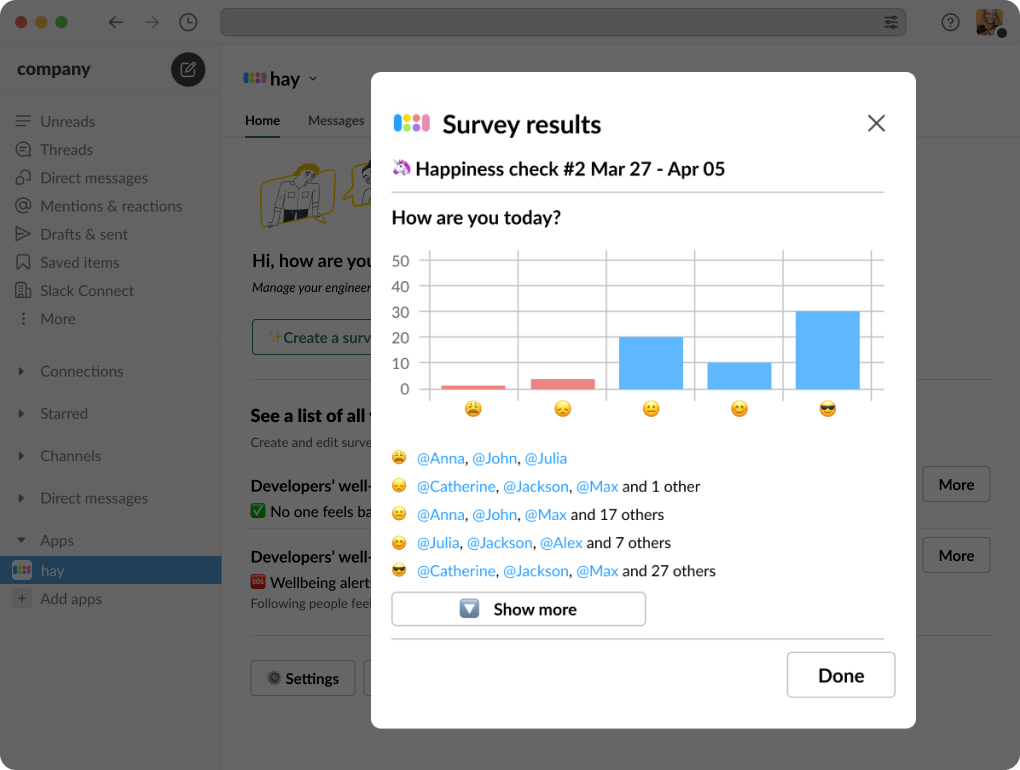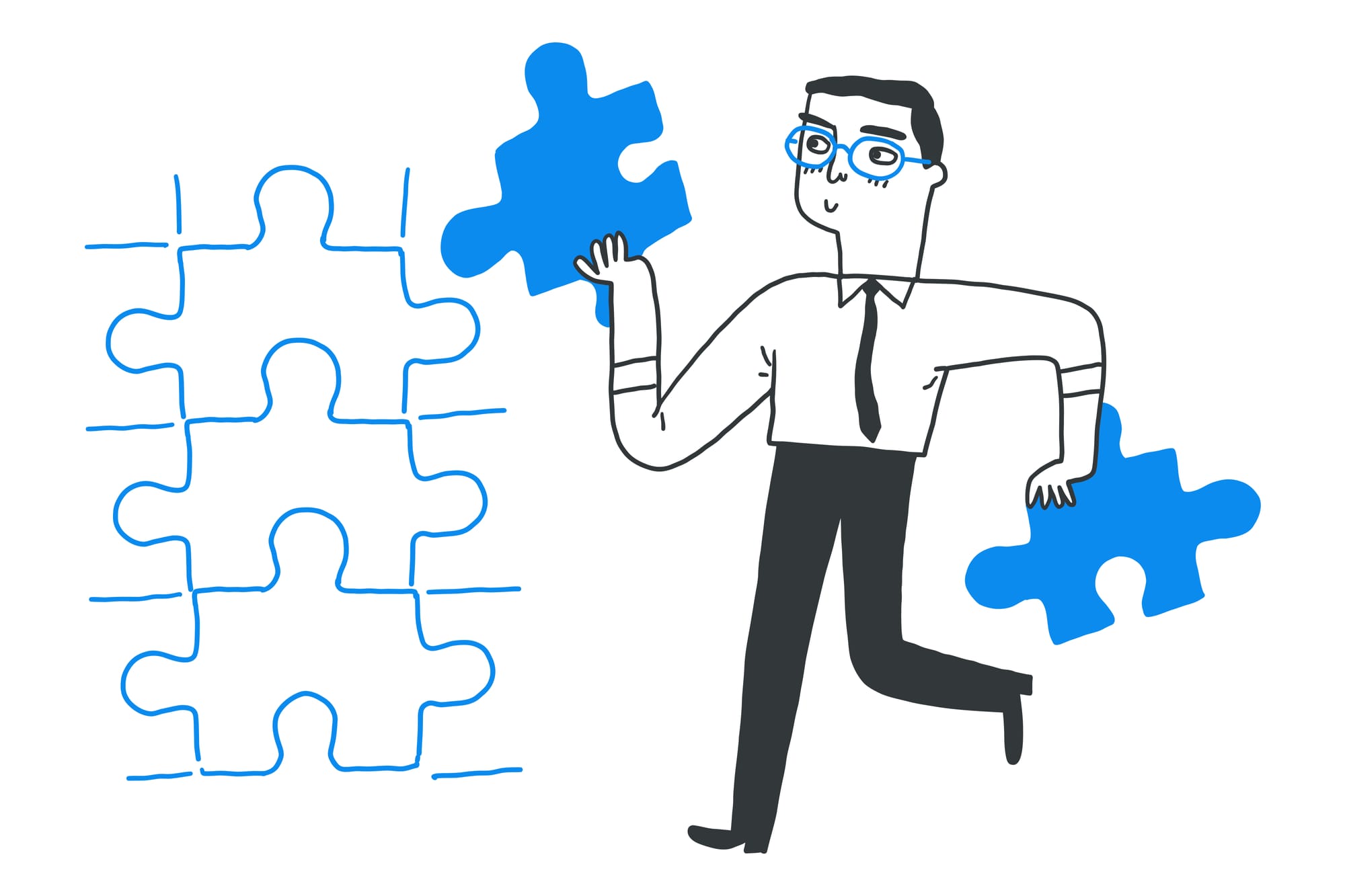While 45 % of companies reported using annual engagement surveys for the last three years, pulse surveys are steadily becoming the preferred method for collecting real-time feedback and driving data-informed decision-making. These pulse surveys act as an early warning system, identifying potential issues before they escalate and allowing for proactive problem-solving.
Major tech giants such as Apple, Etsy, Airbnb, Microsoft, and Amazon have integrated pulse survey apps and platforms into their feedback mechanisms to gauge their employees’ perspectives.
What Is an Employee Pulse Survey?
An employee pulse survey is like a quick check-in to see how your teams are feeling about things. It’s not like an "annual engagement survey" but more regular, like taking a “pulse” to get a sense of what’s going well and what could use some improvement.
Unlike the conventional engagement surveys that arrive in your email occasionally, pulse surveys are succinct, containing a handful of straightforward questions. Modern pulse surveys facilitate communication seamlessly; for instance, they can be quickly made and distributed in platforms like Slack.
The real advantage of pulse surveys lies in their frequency. Being conducted daily or weekly, they enable managers to tap into feedback promptly and detect patterns or trends.
3 Key Benefits of Pulse Surveys in 2024
Streamlining Your Processes and Bolstering Collaboration
Regular pulse surveys grant invaluable insights that can drive specific communication and collaboration plans. This can range from launching team-bonding exercises and initiating consistent team gatherings to introducing tools that simplify project cooperation.
Monitoring Your Team's Wellbeing
Taking care of your employees' mental health and wellbeing is no longer an option - it's a necessity! Burnout is a serious issue too, and with the rise of remote work, it's more important than ever to monitor your team and see how they're doing.
Employee Retention
With competition for top talent at an all-time high, keeping your best employees engaged and happy is crucial. Most employee pulse surveys are nimble, fast, and cost-effective, helping you spot problem areas where you need to make changes. It will also help you understand what motivates your teammates and what factors contribute to their job satisfaction, allowing you to take proactive steps to retain your top talent.
Are Pulse Surveys Really Anonymous?
The anonymity of pulse surveys is a crucial factor that influences employee participation and the honesty of their responses. While many organizations strive to ensure that pulse surveys are anonymous, the level of anonymity can vary depending on the tools and processes used.
Ensuring Anonymity: Most reputable pulse survey platforms are designed to protect employee identities. These platforms often use aggregated data and avoid linking responses to individual employees. However, to maintain true anonymity, it's essential to clearly communicate to employees how their responses will be handled and to reassure them that their feedback cannot be traced back to them personally.
Perceived Anonymity: Even when surveys are designed to be anonymous, the perception of anonymity among employees is equally important. If employees do not believe that their responses are confidential, they may be reluctant to provide honest feedback. Building trust through transparent communication about the survey's anonymity features is vital.
Implementation Practices: To enhance the perception of anonymity, organizations should adopt best practices such as:
- Using third-party survey providers to collect and analyze data.
- Clearly stating the anonymity policy in survey instructions.
- Aggregating data in reports to prevent identification of individual respondents.
- Limiting access to raw data to a few authorized personnel.
In summary, while pulse surveys can be designed to be anonymous, ensuring and communicating this anonymity effectively is essential for gathering honest and useful feedback from employees.
What Is the Difference Between a Pulse Survey and an Employee Engagement Survey?
A pulse survey and an employee engagement survey are both assessment tools used by organizations to gather feedback from their employees.
However, there are some key differences between the two:
Frequency: As mentioned, a pulse survey is typically shorter in length and conducted more frequently, often on a weekly or monthly basis. The survey frequency is crucial in managing survey fatigue and establishing an appropriate cadence to ensure data relevance while maintaining high employee participation. It aims to provide a quick snapshot of employee sentiment and track changes over time.
On the other hand, an employee engagement survey is usually conducted annually or biennially to comprehensively assess overall employee engagement levels. While employee engagement surveys typically receive a response rate of 30-40%, pulse surveys consistently achieve a significantly higher average response rate of 85%.
Scope: Pulse surveys generally focus on specific topics or themes, such as employee wellbeing, satisfaction with recent changes, or feedback on a specific initiative.
Employee engagement surveys cover a broader range of topics and assess overall engagement levels, including factors like job satisfaction, organizational culture, leadership effectiveness, and career development.
Depth of Analysis: Given their frequency and shorter format, pulse surveys provide more immediate insights and enable organizations to identify trends and take quick action. Pulse surveys offer a narrower scope for analysis but can provide real-time feedback for agile decision-making.
Employee engagement surveys, being more comprehensive and conducted less frequently, allow for in-depth analysis and a broader understanding of overall employee engagement levels and drivers.
Why Is Communication Important in Getting Employees to Participate in Employee Pulse Surveys?
Effective communication plays a fundamental role in encouraging employee participation in engagement surveys. By clearly conveying the purpose, process, timing, and intended use of the survey, organizations can cultivate a sense of understanding and trust among employees, motivating them to provide valuable feedback.
When employees are informed about why the survey is being conducted, when and where it will be administered, and how the results will be utilized, they feel more inclined to actively participate. Through proper communication efforts before, during, and after each survey, organizations can establish a transparent and supportive environment that fosters employee engagement and encourages honest and thoughtful responses.
How Should Pulse Surveys Be Planned Into an Organization’s Engagement Survey Cadence?
The planning of pulse surveys into an organization's engagement survey cadence should be thoughtful and tailored to suit the specific needs and capabilities of the organization. A customized approach is crucial since there is no one-size-fits-all solution.
To effectively measure employee engagement, it is recommended to incorporate various survey types at different intervals throughout the year. The cadence should ideally begin with an annual engagement survey, which serves as a baseline to identify key drivers of employee engagement and initiate action planning based on the feedback received.
In addition to the annual survey, it is beneficial to include pulse surveys at strategic points during the year. For example, conducting a pulse survey in the second quarter allows for tracking progress on a specific area of focus identified in the baseline survey. This survey helps to assess whether the actions taken after the initial survey have had a positive impact and determines if any adjustments or further interventions are necessary.
In the third quarter, a deep dive survey can be conducted to explore and diagnose an important topic or issue that may not have been fully understood or addressed in the baseline survey. This targeted survey allows organizations to gain deeper insights and gather more nuanced feedback from employees on a specific area of interest.
To conclude the engagement survey cadence, a pulse survey in the fourth quarter is valuable in following up on a specific area previously highlighted, taking into account the findings and recommendations from the deep dive survey. This survey can include questions that directly address the results and insights obtained from the deep dive survey, providing an opportunity to assess progress made throughout the year.
To ensure optimal participation rates and mitigate survey fatigue, it is essential to communicate the purpose and importance of each survey to employees. Clearly explaining why their feedback is valuable and how it will be used to drive positive change within the organization encourages employees to actively participate.
Finally, it is important to allow enough time between each survey to allow for action planning and implementation based on the survey results. This ensures that the insights gained from the surveys are effectively utilized and not just collected for the sake of measurement.
By carefully planning and incorporating pulse surveys into the engagement survey cadence, organizations can obtain a comprehensive understanding of employee engagement, track progress, diagnose specific areas of concern, and implement targeted actions to drive positive change and improve overall employee satisfaction and engagement.
What Goes Into Creating an Effective Pulse Survey?
Creating an effective pulse survey involves several key elements. Firstly, it is crucial to define a clear purpose for the survey. This purpose may include tracking engagement levels, evaluating the effectiveness of action plans, and demonstrating the significance of employee feedback.
In terms of the survey structure, pulse surveys are generally shorter in length, consisting of around 5-15 questions. These questions should be carefully chosen to capture essential aspects of employee engagement. Core engagement questions should be included to gather insights on various aspects that contribute to employee engagement, such as job satisfaction, communication, work-life balance, and recognition. When constructing pulse survey questions, it is important to provide sample questions and follow best practices to ensure the survey scope is comprehensive and effective.
To ensure the survey provides valuable data, it is advisable to use action-oriented questions. These types of questions assess whether employees have noticed positive changes based on previous survey results, reflecting the impact of actions taken by the organization. Such formatting not only enables the tracking of engagement trends but also aids in understanding the effectiveness of action planning.
Timing is another critical factor in pulse surveys. It is important to survey employees only as frequently as meaningful action can be taken on the results. As employees may experience survey fatigue if surveyed too often without any resulting changes, it is essential to strike a balance between obtaining regular feedback and avoiding overwhelming employees with excessive surveys.
Lastly, it is worth noting that pulse surveys should be conducted regularly to maintain a continuous feedback loop and enable organizations to adapt their strategies based on employee responses. By regularly collecting feedback, organizations can stay on top of evolving employee needs and concerns, driving continuous improvement and fostering a culture of open communication.
In summary, an effective pulse survey requires a clear purpose, carefully selected core engagement questions, action-oriented formatting, appropriate timing, and regular implementation. By following these guidelines, organizations can create pulse surveys that provide valuable insights, facilitate positive change, and demonstrate the significance of employee feedback.
Why Use HAY’s Pulse Survey?
We've extensively researched the efficacy of pulse surveys in overseeing wellbeing and satisfaction. Our data suggests that insights collected by managers serve as pivotal action points to tackle challenges their teams encounter.
Also, we discovered that administering and following up on pulse surveys can also help decrease turnover, improve culture, and find out if employees need to upskill. You can also use pulse survey data to see who’s at risk of burnout and loss of productivity.
How To Use HAY’s Pulse Survey?
Step 1: Determine the Purpose of the Survey
Before creating a survey, it's important to know the survey’s purpose. For example, are you looking to measure overall happiness or see if your employees are happy using their tools? Perhaps you’d like to gather feedback about how they feel working on their projects. By determining the purpose of the survey, you can then tailor the questions to meet your specific needs.
Step 2: Create Your Survey Questions
Make sure that the survey questions align with the purpose of the survey. It's also important to keep the questions simple and easy to understand to get an accurate and honest response from your direct reports.
You may want to consider asking questions about physical health, mental health, stress levels, work-life balance, and workplace culture.
Step 3: Input Your Survey Questions + 15 Sample Questions To Ask Your Employees
When you know precisely the questions you want to ask, start creating your survey by clicking on the HAY icon in ‘Apps’. This opens up the HAY dashboard. If you’ve created a survey before, you’ll be able to see all your wellbeing alerts. Note: only individuals feeling bad will be shown in the wellbeing alert.
Here are some sample questions:
- How satisfied are you with your project?
- How strongly do you agree that the team is working efficiently together?
- How well do you feel supported by your manager when it comes to achieving your goals?
- How much do you enjoy working on the technologies used in the project?
- How satisfied are you with the current level of documentation for your project?
- How well do you feel your ideas and suggestions are heard and considered by your teammates?
- How strongly do you agree that there is enough collaboration and communication within the team?
- How satisfied are you with the level of autonomy you have in your role?
- How strongly do you agree that you have the necessary resources (tools, training, etc.) to do your job effectively?
- How satisfied are you with your work-life balance?
- How well do you feel the project requirements and timelines are communicated to you?
- How strongly do you agree that you feel valued and appreciated by your manager and teammates?
- How satisfied are you with the current project management and planning processes?
- How strongly do you agree that there is enough recognition and reward for good work within the team?
- How well do you feel you are able to contribute to the project's overall success?
Click on ‘Create a survey.’
Here, you can write your survey title and a message to your team. You might want to include a clear deadline for responses and also encourage your direct reports to complete the survey.
Start adding the questions to your survey.
Under ‘Settings,’ choose the individuals you want to receive the survey and the date you want to send the survey out. You can also choose to have the survey sent out Once, Weekly, Biweekly, Triweekly, or Monthly.
Step 4: See Your Survey Results
When the survey is finished, you could check the pulse survey results as they’re dynamically generated in a bar graph. If some of your direct reports haven’t filled out the survey yet, you could send a quick reminder. There’s also the option of pausing the survey or archiving it.
Here are what the survey results will look like.

The pulse survey results will allow you to identify trends and areas of concern, such as high levels of stress or dissatisfaction with workplace culture. Your answers will depend on the questions you asked.
Step 5: Develop an Action Plan
This is the most important part of the survey. With the survey complete and fresh data at your fingertips, using pulse survey software to access real-time results and ensure user-friendliness, you’ll now be able to discuss with your teams the results in a one-on-one meeting.
Your action plan may include implementing new wellbeing initiatives, enhancing existing programs, or providing resources and support to your teammates. Be sure to establish goals for your action plan and track progress in order to measure and improve factors that increase happiness, engagement, and productivity.
Using a pulse survey to measure wellbeing at the workplace can provide valuable insights. With HAY for Slack, you can create and administer a pulse survey that meets your specific needs and helps promote a culture of honesty and openness at your company 😊





